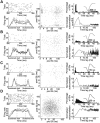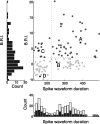Attentional modulation of firing rate varies with burstiness across putative pyramidal neurons in macaque visual area V4
- PMID: 21795547
- PMCID: PMC3161825
- DOI: 10.1523/JNEUROSCI.0027-11.2011
Attentional modulation of firing rate varies with burstiness across putative pyramidal neurons in macaque visual area V4
Abstract
One of the most well established forms of attentional modulation is an increase in firing rate when attention is directed into the receptive field of a neuron. The degree of rate modulation, however, can vary considerably across individual neurons, especially among broad spiking neurons (putative pyramids). We asked whether this heterogeneity might be correlated with a neuronal response property that is used in intracellular recording studies to distinguish among distinct neuronal classes: the burstiness of the neuronal spike train. We first characterized the burst spiking behavior of visual area V4 neurons and found that this varies considerably across the population, but we did not find evidence for distinct classes of burst behavior. Burstiness did, however, vary more widely across the class of neurons that shows the greatest heterogeneity in attentional modulation, and within that class, burstiness helped account for differences in attentional modulation. Among these broad spiking neurons, rate modulation was primarily restricted to bursty neurons, which as a group showed a highly significant increase in firing rate with attention. Furthermore, every bursty broad spiking neuron whose firing rate was significantly modulated by attention exhibited an increase in firing rate. In contrast, non-bursty broad spiking neurons exhibited no net attentional modulation, and, although some individual neurons did show significant rate modulation, these were divided among neurons showing increases and decreases. These findings show that macaque area V4 shows a range of bursting behavior and that the heterogeneity of attentional modulation can be explained, in part, by variation in burstiness.
Figures





References
-
- Barthó P, Hirase H, Monconduit L, Zugaro M, Harris KD, Buzsáki G. Characterization of neocortical principal cells and interneurons by network interactions and extracellular features. J Neurophysiol. 2004;92:600–608. - PubMed
-
- Cavanagh P, Alvarez GA. Tracking multiple targets with multifocal attention. Trends Cogn Sci. 2005;9:349–354. - PubMed
Publication types
MeSH terms
Grants and funding
LinkOut - more resources
Full Text Sources
